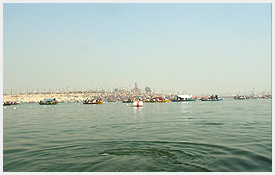» About Haridwar
» About Rishikesh
» About Ujjain
» About Nashik
» About Allahabad
» About Ganga
» About Akharas
» About Ayurveda
» About Yoga
» About Festivals
»About Kumbh Mela
» Ardh Kumbh
» Haridwar Information
» Haridwar Tourist Information
» Ayurveda Tours
» Chandrashilla Sumit Trekking
» Dehradun Mussoorie
» Dodi Tal Trekking
» Gangotri Trek Tour
» Golden Triangle Tour
» Har Ki Dun Trek
» Haridwar Rishikesh Jaipur Tour
» Chardham Pilgrimage
» Kumbh Itinerary Detail
» Footstep Lord Buddha
» Jain Yatra Kutchh
» Kailash Darshan By Foot
» Kailash Darshan By Helicopter
» Lhasa Kailash Mansarovar Yatra
» Muktinath Darshan Yatra

Home - About Allahabad
About Allahabad
The name Allahabad was given by Mughal Emperor Akbar the great in 1584 which means the  city of Allah (god). Earlier it was known by the name Prayaga or Prayaga raja which means the location where holy rivers meet. The Sangam of the Ganga, the Yamuna and the Saraswati in Allahabad is more significance as this is the place where Lord Rama with his wife Sita and brother laxmana came and spent time near it at Bharadvaja’s asharam during his exile from Ayodhya. It is also believed and mentioned in the Mahabharata that the five Pandavs also visited Prayaga during their exile. During battle of kuruksetra, Lord Balarama also visited this place while touring several holy places around 5000 years ago and Lord Nityananda took bath in the holy river here while traveling from Jagannatha Puri to Vrindavana. It is also said that in Vedic period, Lord Brahma, the creator of the universe, attended the sacrificial rituals.
city of Allah (god). Earlier it was known by the name Prayaga or Prayaga raja which means the location where holy rivers meet. The Sangam of the Ganga, the Yamuna and the Saraswati in Allahabad is more significance as this is the place where Lord Rama with his wife Sita and brother laxmana came and spent time near it at Bharadvaja’s asharam during his exile from Ayodhya. It is also believed and mentioned in the Mahabharata that the five Pandavs also visited Prayaga during their exile. During battle of kuruksetra, Lord Balarama also visited this place while touring several holy places around 5000 years ago and Lord Nityananda took bath in the holy river here while traveling from Jagannatha Puri to Vrindavana. It is also said that in Vedic period, Lord Brahma, the creator of the universe, attended the sacrificial rituals.
Beside the river sangam, there are few more sites to be visited in Allahabad and are of national heritage, namely, Anand Bhawan, birth place of India’s first prime minister, now turned into a museum displaying personal collection of Nehru family, high court of United Province, Ashoka pillar inside a huge fort and a banyan tree in good condition which is more than 1000 years old, Hanuman temple open to all the visitors, Adi Shankara Temple is one of the examples of finest carving and a balaji deity. Shringayerpur is one of the major attraction for tourists, Lord Rama, sita and laxman crossed the Ganga on their way to exile, new Yamuna bridge near Yamuna bank road, Company Bagh, Alfred Park, Patthar Girja Ghar or All Saints Cathedral was built in 13th century at eminent location which was designed by English architect William Emerson and it is the most beautiful building in the city, Ewing Christian college established in 1902 by Americans. The buildings here are old and reflect the western and mughal architectures.
Muir College, designed by William Emerson in 1874, in Indo-Saracenic architecture is a wonderful blend of Gothic and Indian architectural elements. It has an arcade quadrangle, which is dominated, by a 200 feet minaret tower in cream colored sandstone from Mirzapur with marble and mosaic floors. The domes of the Indo-Saracenic structure are clad in Multan glazed tiles.
The city is full of greenery. It is one of the fastest growing cities in the state Uttar Pradesh. Climate changes through out the year- hot dry summer from April to June, cool dry winter and warm humid monsoon from July beginning to September.
The city is known for its sporting spirit in Cricket, Badminton, Tennis and Gymnastics. There are ample of sports complexes for both amateurs and professionals such as Madan Mohan Malaviya Cricket stadium, Mayo Hall Sports Complex and the Boys' High School & College Gymnasium. There are several swimming facilities throughout the city as well. Mohammed Kaif, Indian cricket player, also belongs to Allahabad. Another renowned sporting personality from Allahabad is Abhinn Shyam Gupta who won the National title of badminton in 2002.
The urban area of Allahabad is divided into three categories- Old city, an economic centre of the city with high density of traffic as these roads are transport corridors as well as market streets. The Newer city, have major educational institutions, gardens, offices and cantonment areas with wide open roads with lush green surroundings. The outer growth area, it connects the city to major highways.




